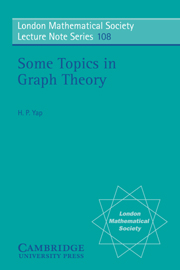Chapter 1 - Basic Terminology
Published online by Cambridge University Press: 19 March 2010
Summary
Basic graph-theoretic terms
In this section we shall define some basic graph-theoretic terms that will be used in this book. Other graph-theoretic terms which are not included in this section will be defined when they are needed.
Unless stated otherwise, all graphs are finite, undirected, simple and loopless. A directed graph is called a digraph and a directed edge is called an arc. A multigraph permits more than one edge joining two of its vertices. The number of edges joining two vertices u and v is called the multiplicity of uv and is denoted by μ(u,v).
The cardinality of a set S is denoted by |s|. Let G = (V,E) be a graph where V = V(G) is its vertex set and E = E(G) is its edge set. The order (resp. size) of G is |v| (resp. |E|) and is denoted by |G| (resp. e(G)). Two vertices u and v of G are said to be adjacent if uv ε E. If e = uv ε E, then we say that u and v are the end-vertices of e and that the edge e is incident with u and v. Two edges e and f of G are said to be adjacent if they have one common end-vertex. If uv ε E, then we say that v is a neighbour of u. The set of all neighbours of u is called the neighbourhood of u and is denoted by NG(U) or simply by N(u) if there is no danger of confusion. The valency (or degree) of a vertex u is |N(u)| and is denoted by d(u).
- Type
- Chapter
- Information
- Some Topics in Graph Theory , pp. 1 - 8Publisher: Cambridge University PressPrint publication year: 1986

